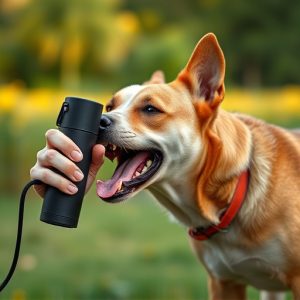Dog Spray: Active Ingredients for Safe, Effective Deterrence
Dog repellent sprays effectively deter canine behavior through active ingredients like capsaicin, ci…….
Dog repellent sprays effectively deter canine behavior through active ingredients like capsaicin, citronella, and essential oils, creating an unpleasant sensory experience without causing harm. Choosing repellents with carefully selected natural or synthetic compounds ensures reliability and safety. For optimal use, strategically identify problem areas, apply liberal amounts of spray, follow safety guidelines, and reapply regularly, especially after weather changes.
Dog spray, a powerful tool in pet ownership, offers a safe and effective solution for deterring unwanted dog behavior. This article explores the fundamentals of understanding dog spray, delving into the active ingredients that make it a potent deterrent. We’ll uncover how these components work, providing application tips and safety measures to ensure maximum effectiveness while keeping your space protected. Discover the key to maintaining a peaceful environment with our guide on the active ingredients in dog repellent spray.
- Understanding Dog Spray: The Basics
- Unlocking the Power of Active Ingredients
- Application and Safety Measures for Effective Deterrence
Understanding Dog Spray: The Basics
Dog spray, also known as dog repellent spray, is a popular and effective solution for managing unwanted canine behavior. When considering the active ingredients in dog repellent spray, it’s crucial to understand what makes them work. These sprays typically contain a combination of natural and synthetic compounds that produce an unpleasant scent or irritation when applied, safely deterring dogs from specific areas or behaviors.
The key active ingredients often include capsaicin, citronella, and other essential oils. Capsaicin, derived from chili peppers, creates a burning sensation in the nose and throat, making it highly effective in repelling dogs without causing any lasting harm. Citronella, commonly found in insect repellents, has a strong scent that can deter dogs when sprayed onto surfaces or grass areas. Additionally, certain essential oils like lavender and peppermint are known for their calming properties for humans while still being unappealing to dogs.
Unlocking the Power of Active Ingredients
The effectiveness of any dog spray largely hinges on its active ingredients—the key compounds that trigger a response from the animal’s senses. Understanding these active ingredients is crucial in choosing a safe and reliable deterrent. Modern dog repellents often incorporate natural or synthetic substances known for their scent-based deterrence, such as capsaicin (derived from chili peppers) or ferulic acid (found in plants). These compounds stimulate sensory receptors in dogs, causing them to experience discomfort or even fear, thereby discouraging unwanted behaviors like barking, jumping, or marking territory.
The power of active ingredients lies not just in their ability to repel but also in their selectivity. Effective dog sprays aim to deter without causing harm. For instance, unlike traditional colognes that might mask smells, these active ingredients specifically target the canine olfactory system, ensuring that dogs receive a clear signal without experiencing adverse effects. This balance of efficacy and safety is what makes certain dog spray products standout as game-changers in pet ownership, offering both peace of mind and effective behavior management.
Application and Safety Measures for Effective Deterrence
When using dog spray for deterrence, understanding the application process is key to its effectiveness. Begin by identifying the specific areas where dogs tend to congregate or mark territory. Spray the chosen areas liberally, ensuring thorough coverage. The active ingredients in dog repellent sprays, such as capsaicin or citronella, create an unpleasant sensory experience, discouraging dogs from returning. It’s important to follow the product instructions carefully and ensure proper ventilation during application.
Safety measures are paramount when handling any spray. Wear protective gear, including gloves and a mask, to avoid direct contact with skin and inhalation of fumes. Keep the spray out of reach of children and pets, and store it in a secure, labeled container. In case of accidental exposure, have eye wash or a solution of warm water and mild soap ready for immediate cleaning. Regular reapplication is recommended, especially after rainfall or high winds, to maintain the deterrent effect.
Dog spray, when used correctly, can be an effective and safe deterrent for keeping dogs away from unwanted areas. By understanding the active ingredients and applying them appropriately, pet owners can protect their property while maintaining a humane approach. Remember to always follow safety measures and choose a reputable product to ensure the best results without causing harm to your furry friends or the environment.


